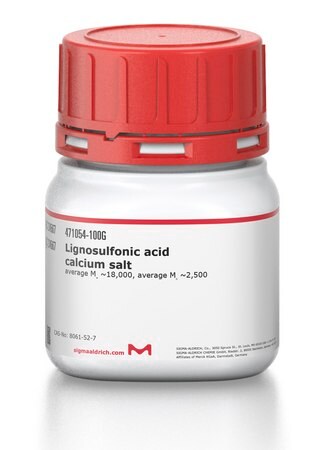Sigma-Aldrich Lignosulfonic acid calcium salt
Catalog No :
CAS Number :
Brand :
In Stock
average Mw ~18,000, average Mn ~2,500
Specifications:
| Storage Temperature | Room Temperature | ||
| Product Type | Laboratory Chemical | Forms | Powder |
| Product Brand | Sigma-Aldrich | ||
| Product Grade | Analytical grade | ||
Lignosulfonic acid calcium salt is a water-soluble compound derived from lignin, a natural polymer found in the cell walls of plants. It is commonly used in various industrial and scientific applications due to its binding, dispersing, and complexing properties.
Properties
| Property | Details |
|---|---|
| Molecular Weight (Mn) | Average Mn: ~2,500 |
| Molecular Weight (Mw) | Average Mw: ~18,000 |
| Composition | Calcium (Ca): 5 wt. % |
| Impurities | Reducing sugars: 16 wt. % |
| Solubility | Soluble in water (H₂O). |
| InChI | 1S/C20H26O10S2.Ca/c1-28-18-7-3-6-15(20(18)21)12-16(13-32(25,26)27)30-17-9-8-14(11-19(17)29-2)5-4-10-31(22,23)24;/h3,6-9,11,16,21H,4-5,10,12-13H2,1-2H3,(H,22,23,24)(H,25,26,27);/q;+2/p-2 |
| InChI Key | RYAGRZNBULDMBW-UHFFFAOYSA-L |
Chemical Composition
Lignosulfonic acid calcium salt contains a combination of:
- Lignin-derived sulfonated polymers: These provide dispersant and binder properties.
- Calcium ions (Ca2+): These stabilize the compound and contribute to its reactivity.
- Impurities: The presence of reducing sugars (~16 wt. %) can influence its behavior in chemical and biological systems.
Physical and Chemical Properties
- Structure:
- Lignosulfonic acid calcium salt is a complex polymeric compound with both hydrophobic and hydrophilic components, enabling interactions with a wide range of substances.
- Molecular Weight:
- The large difference between Mn (~2,500) and Mw (~18,000) indicates a polydisperse system, typical of lignin derivatives.
- Solubility:
- Its water solubility makes it versatile for aqueous systems, including formulations, dispersions, and bioprocessing.
Applications
- Industrial Uses:
- Binder: Used in pelletizing, briquetting, and as a binder in ceramics and refractories.
- Dispersant: Helps stabilize suspensions in concrete, dyes, and pesticide formulations.
- Additive: In drilling fluids, acts as a thinning agent and stabilizer.
- Agriculture:
- Acts as a soil conditioner and dispersing agent for fertilizers and pesticides.
- Pharmaceutical and Food:
- Used as an emulsifier and stabilizer in certain formulations (with restrictions on impurities).
- Animal Feed:
- Serves as a pellet binder, improving the physical quality of feed.
- Environmental Applications:
- Used in water treatment as a dispersant and flocculant.
- Effective in dust control and soil stabilization.
Advantages
- Eco-Friendly: Derived from renewable lignin sources.
- Versatile: Functional in a variety of applications due to its dispersing and binding properties.
- Water-Soluble: Easy to handle and apply in aqueous systems.
Limitations
- Impurities: The presence of reducing sugars (16 wt. %) may limit its use in certain high-purity applications.
- pH Sensitivity: May degrade under extreme pH conditions.
Safety and Handling
- Stability: Generally stable under standard storage conditions.
- Safety Measures: Avoid inhalation of dust and prolonged skin contact. Use protective gear when handling in industrial quantities.
Lignosulfonic acid calcium salt is a multifunctional material offering a balance of environmental friendliness, cost-effectiveness, and versatility, making it valuable across diverse industries.




 0
0
